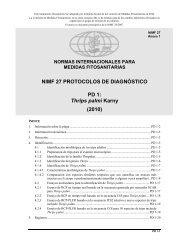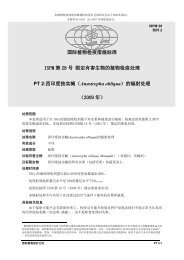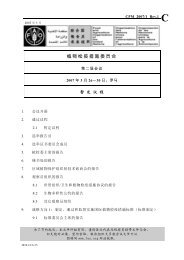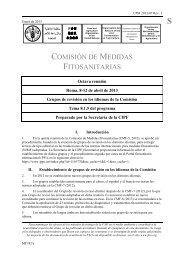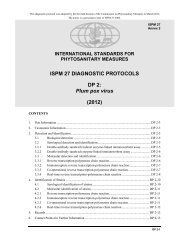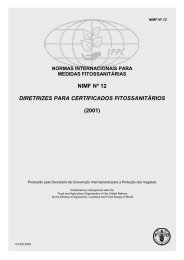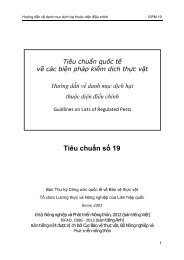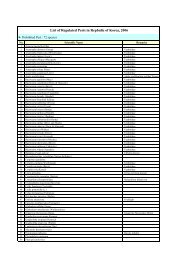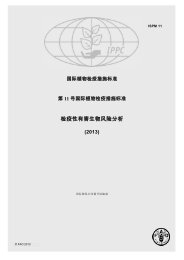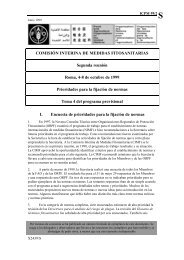Overview of the management of invasive alien species from the ...
Overview of the management of invasive alien species from the ...
Overview of the management of invasive alien species from the ...
Create successful ePaper yourself
Turn your PDF publications into a flip-book with our unique Google optimized e-Paper software.
<strong>Overview</strong> <strong>of</strong> <strong>the</strong> <strong>management</strong> <strong>of</strong><br />
<strong>invasive</strong> <strong>alien</strong> <strong>species</strong><br />
<strong>from</strong> <strong>the</strong> environmental perspective<br />
Clare Shine<br />
IUCN Commission on Environmental Law<br />
IUCN Invasive Species Specialist Group<br />
with <strong>the</strong> help <strong>of</strong> many contributors to <strong>the</strong><br />
Global Invasive Species Programme (GISP)
Points to be covered<br />
1. Why are IAS an international environmental issue<br />
2. What instruments and tools have been developed<br />
3. What are <strong>the</strong> main gaps and constraints<br />
4. How should we move forward – at <strong>the</strong> national,<br />
regional and global level
1. Why have IAS become an<br />
international environmental issue<br />
Only a subset <strong>of</strong> <strong>alien</strong> <strong>species</strong> go on to be problematic…<br />
But those that do can have multiple impacts affecting<br />
different sectors and native biodiversity<br />
Economic, environmental and public health implications<br />
for all countries
Consequences - Environmental<br />
IAS are among <strong>the</strong> top<br />
drivers <strong>of</strong> environmental<br />
change globally (Sala(<br />
et<br />
al. 2000).<br />
IAS are <strong>the</strong> second greatest<br />
threat to Threatened and<br />
Endangered <strong>species</strong> in<br />
<strong>the</strong> U.S. (Wilcove(<br />
et al.<br />
1988).
Consequences - Economic<br />
Introduced <strong>from</strong> Latin America as<br />
a high protein food source, <strong>the</strong><br />
golden apple snail caused losses to<br />
Philippine rice crops during <strong>the</strong><br />
1980’s <strong>of</strong> @ $1 billion (Naylor<br />
1996).<br />
Losses to agriculture globally:<br />
$55-248 billion/year.<br />
Costs to U.S. estimated to be<br />
at least $100 billion/year<br />
(Pimentel et al. 2000).
Consequences - Economic<br />
Eradication and Control - Direct Costs<br />
European gypsy moth. Introduced into North<br />
Carolina in 1993. Took 4 years to eradicate it<br />
and cost @ US$19 million.<br />
Sea Lamprey. The US Department <strong>of</strong> State<br />
spends more than US$10 million annually to<br />
control in <strong>the</strong> Great Lakes <strong>of</strong> US/Canada.<br />
Brown tree snake. Control-related related efforts<br />
have cost <strong>the</strong> US military @ US$2 million<br />
annually since 1993.
Consequences - Human Health<br />
Giant African Snail (Achatina(<br />
fulica)<br />
• “Hitchhiker”<br />
• Potential Food Source<br />
• Pets<br />
Intermediate host for “rat lungworm”<br />
(Angiostrongylus<br />
cantonensis) which can<br />
infect <strong>the</strong> human brain, causing<br />
headache, fever, paralysis, coma, and<br />
even death (Roberts and Janovy 1996).
Consequences - Political<br />
Barriers to<br />
Sustainable<br />
Development<br />
• Food Security<br />
• Human Health<br />
• Water Security<br />
• Poverty<br />
• Regional Conflict<br />
• Migration
Consequences - Political<br />
Invasive <strong>alien</strong> <strong>species</strong> could prevent<br />
governments and industries <strong>from</strong>:<br />
• Selling some types <strong>of</strong> food products<br />
• Selling “living” commodities<br />
• Using certain kinds <strong>of</strong> containers<br />
Barriers to<br />
international trade<br />
and economic<br />
growth<br />
Freight Solutions Int’l.
Effects <strong>of</strong> <strong>invasive</strong> plants<br />
•Competition with native taxa <strong>of</strong> flora<br />
•Hybridization with genetically close <strong>species</strong><br />
•Changes <strong>of</strong> <strong>the</strong> physical and chemical characteristics <strong>of</strong><br />
<strong>the</strong> soil<br />
•Modification <strong>of</strong> natural and seminatural habitats<br />
•Propagation <strong>of</strong> pests and diseases
Statistics <strong>from</strong> <strong>the</strong> Working for Water<br />
programme (South Africa)<br />
http://www-dwaf.pwv.gov.za/wfw<br />
• Invading <strong>alien</strong> plants (IAPs) <strong>the</strong> single biggest threat to plant and<br />
animal biodiversity.<br />
• Established in over 10 million hectares <strong>of</strong> land in South Africa.<br />
• Cost <strong>of</strong> controlling IAPs in South Africa estimated at R600<br />
million a year over 20 years and will double within 15 years.<br />
• IAPs waste 7% <strong>of</strong> our water resources; reduce our ability to farm;<br />
intensify flooding and fires; cause erosion, destruction <strong>of</strong> rivers,<br />
siltation <strong>of</strong> dams and estuaries, and poor water quality and can<br />
cause a mass extinction <strong>of</strong> indigenous plants and animals.
Melaleuca quinquenervia invading<br />
(Photo courtsey <strong>of</strong> The Nature Conservancy)
Miconia calvescens. Considered <strong>the</strong> most <strong>invasive</strong> and damaging <strong>of</strong> <strong>alien</strong> plant<br />
<strong>species</strong> to wet forests <strong>of</strong> Pacific islands In Tahiti, over 60% <strong>of</strong> <strong>the</strong> island<br />
is heavily invaded, replacing <strong>the</strong> forest and its wildlife. Introduced to Hawaii as an<br />
ornamental in <strong>the</strong> 1960s; sold by several nurseries before being listed<br />
as a noxious weed in 1992.
Water hyacinth in East Africa
Red imported fire ants impact…<br />
Public health<br />
Biodiversity<br />
Electrical systems<br />
Agriculture and<br />
livestock production
Range Expansion <strong>of</strong> Red Imported Fire Ants in <strong>the</strong> USA<br />
1939-1998<br />
Source: California Dept <strong>of</strong> Food and Ag.
adapted <strong>from</strong> Davis et al. 2001
Most vulnerable ecosystems<br />
• Geographically/evolutionarily isolated ecosystems (islands, mountain<br />
ranges, lakes etc.)<br />
• Unique flora and fauna and biological communities<br />
Some statistics:<br />
• 1% <strong>of</strong> all endemic plants are found in American Samoa<br />
• Hawaii - 90% endemism for flowering plants, 99% for insects<br />
• Hawaii’s rate <strong>of</strong> invasion 500x <strong>the</strong> rate per unit area for mainland U.S.<br />
for insects and mites (R.C.McGregor 1973)
2. What instruments and tools have been<br />
developed to address pathways for<br />
transmission <strong>of</strong> IAS<br />
• Focus on <strong>the</strong> global level<br />
for <strong>the</strong> time being
Boat traffic<br />
Air traffic<br />
Cargo<br />
Passenger<br />
Ballast<br />
water<br />
Hull<br />
fouling<br />
Aqua<br />
culture<br />
Ornamentals<br />
Forestry trees<br />
Hunting<br />
+ Food<br />
Soil<br />
improvement<br />
Marine<br />
environment<br />
Adapted <strong>from</strong> Wittenberg R., 2000<br />
Terrestrial<br />
Importer State<br />
Freshwater<br />
Fisheries
International regulatory framework<br />
Protection <strong>of</strong><br />
plant, animal<br />
and human<br />
health<br />
Nature<br />
conservation<br />
&<br />
biodiversity<br />
Risks<br />
associated<br />
with some<br />
transport and<br />
trade<br />
pathways
Instruments for <strong>the</strong> protection <strong>of</strong><br />
plant, animal and human health<br />
• IPPC/ICPM and Office International des Epizooties<br />
Long-established part <strong>of</strong> international framework; close<br />
links to national quarantine and border control services<br />
• <strong>the</strong> interests <strong>the</strong>y protect may be adversely affected by<br />
<strong>alien</strong> animals, plants and micro-organisms (viruses,<br />
bacteria and fungi) that become <strong>invasive</strong><br />
• focus is not explicitly environmental BUT some<br />
countries already use IPPC framework to support<br />
assessment <strong>of</strong> environmental risks
Protection <strong>of</strong> plant health<br />
IPPC covers <strong>invasive</strong> <strong>alien</strong> <strong>species</strong> IF <strong>the</strong>y meet<br />
definition <strong>of</strong> « pest ». Covers mandate <strong>of</strong> national<br />
plant protection organisations and measures for<br />
import control, risk analysis, surveillance,<br />
control <strong>of</strong> incursions, export certification etc.<br />
Regional Plant Protection Organisations<br />
Regional organisations within global IPPC<br />
framework. May develop regional standards<br />
consistent with regional needs and priorities
Plant protection (continued(<br />
continued)<br />
New international phytosanitary standards (ISPMs)<br />
provide guidance on <strong>the</strong> application <strong>of</strong> pest risk analysis<br />
to a specific set <strong>of</strong> risks related to <strong>the</strong> environment<br />
ISPM for a known invasion pathway approved 2002<br />
(Guidelines for regulating wood packaging material<br />
in international trade, aims to reduce <strong>the</strong> risk <strong>of</strong><br />
introduction and/or spread <strong>of</strong> quarantine pests via<br />
this pathway (ISPM 15)).
Plant protection (developments(<br />
in 2003)<br />
Supplement on Analysis <strong>of</strong> environmental risks to<br />
ISPM No.11 (PRA for quarantine pests, 2001)<br />
approved 2003. Provides guidance for coverage<br />
<strong>of</strong> taxa that impact unmanaged as well as<br />
agricultural systems.<br />
IPPC Supplement No. 2 on Guidelines on <strong>the</strong> understanding<br />
<strong>of</strong> Potential Economic Importance’ and related terms<br />
including reference to environmental considerations<br />
(to ISPM No.5 (Glossary <strong>of</strong> Phytosanitary Terms).<br />
Potential harmful impact on plants may include damage to<br />
ecosystems, habitats or <strong>species</strong> or o<strong>the</strong>r specified values<br />
such as recreation, tourism or aes<strong>the</strong>tics).
Biodiversity-related<br />
related instruments<br />
• <strong>alien</strong> <strong>species</strong> referenced <strong>from</strong> 1980s, but <strong>of</strong>ten in<br />
limited ways (e.g. just protected areas/prevention).<br />
• Convention on Biological Diversity 1992: <strong>the</strong> first<br />
global instrument to mandate comprehensive<br />
approach to « <strong>alien</strong> <strong>species</strong> that threaten<br />
ecosystems, habitats or <strong>species</strong> »
Biodiversity (developments<br />
in 2002)<br />
CBD Decision VI/23 & Guiding Principles promote:<br />
• hierarchical approach to prevention, eradication, containment/control<br />
• research, monitoring, inter-State and regional cooperation,<br />
information exchange between trading partners, precautionary and<br />
ecosystem approaches, risk assessment <strong>of</strong> intentional introductions<br />
and pathways, capacity-building…<br />
Several <strong>of</strong> <strong>the</strong>se tools well-established under IPPC but not systematically<br />
applied to biodiversity considerations at national level<br />
CBD prioritises application to specific ecosystems and biogeographic<br />
units. Progress to date on wetlands, islands, Global Strategy for Plant<br />
Conservation.
Non-binding<br />
codes<br />
for transport and o<strong>the</strong>r pathways<br />
At sea<br />
Ballast water have<br />
been addressed<br />
but not hull-fouling )<br />
In <strong>the</strong> air<br />
International Civil<br />
Aviation Organisation<br />
survey under way.<br />
Nothing to address<br />
military aviation as a<br />
pathway<br />
O<strong>the</strong>r<br />
Codes <strong>of</strong> conduct<br />
for aquaculture<br />
(FAO, producers);<br />
some national codes<br />
on pets, aquatic<br />
trade,<br />
ornamentals…
Status <strong>of</strong> national prevention measures within<br />
<strong>the</strong> multilateral trade framework<br />
• WTO Agreement on <strong>the</strong> Application <strong>of</strong> Sanitary and Phytosanitary<br />
Measures (1995) provides for use <strong>of</strong> international standards to<br />
promote harmonisation and avoid disguised barriers to trade<br />
• recognises IPPC and OIE as competent to set standards<br />
• adoption predates international focus on IAS – but Members may<br />
develop national measures to protect people, animals and plants, and<br />
<strong>the</strong> environment against pests, diseases, disease-carrying organisms<br />
and disease-causing organisms<br />
• probably broad enough to allow importing countries to address IAS if<br />
national resources for RA, effective agencies and legislation ….
3. What are <strong>the</strong> main gaps<br />
and constraints
Lack <strong>of</strong> standards for managing<br />
environmental pests and animals that<br />
<strong>the</strong>mselves could be <strong>invasive</strong><br />
• IPPC and OIE do not cover organisms that are not animal diseases or<br />
plant pests (“environmental pests”)<br />
• So IPPC does not cover e.g. termites, poisonous spiders, <strong>alien</strong><br />
nematodes that are "orphans" or hitchhiker/contaminants but not plant<br />
pests (eg. spiders in table grapes, ants in taro)<br />
• New ISPMs do not extend scope <strong>of</strong> IPPC in this respect<br />
• Countries can do this e.g. New Zealand Import Health Standards<br />
extend IPPC “pest” definition to include all those new organisms that<br />
may affect <strong>the</strong> economy, human health or <strong>the</strong> environment
O<strong>the</strong>r key pathway gaps<br />
• no binding measures on aquaculture and<br />
o<strong>the</strong>r deliberate introductions into<br />
aquatic ecosystems<br />
• lack <strong>of</strong> binding controls on shipping<br />
(ballast water, hull fouling)<br />
• NB growing Internet-based trade in<br />
‘exotic’ seeds, bulbs and plants<br />
• no measures or guidance to reduce<br />
pathway risks for natural disaster relief<br />
& assistance. foods, seeds…
Constraints at <strong>the</strong> regional level<br />
• Lack <strong>of</strong> measures to address transboundary issues (e.g. in<br />
continental land masses where a country’s decisions can<br />
pose immediate risks to neighbours)<br />
• In free trade areas, removal or liberalisation <strong>of</strong> border<br />
controls may facilitate <strong>the</strong> movement <strong>of</strong> potentially <strong>invasive</strong><br />
<strong>alien</strong> <strong>species</strong> between different countries and ecosystems<br />
• under-development <strong>of</strong> regional risk assessment support and<br />
capacity-building (some regions)
Common constraints at <strong>the</strong> national level<br />
Lack <strong>of</strong> public, political and media awareness<br />
Capacity, resource and information constraints<br />
Fragmented legal and institutional frameworks<br />
• no strategic approach<br />
• outdated/inconsistent laws to address agricultural-environmentmarine-public<br />
health concerns<br />
• poor coordination between agriculture, border protection,<br />
fisheries, environment, public health, tourism, o<strong>the</strong>r agencies<br />
Gaps in coverage and terminology<br />
Low levels <strong>of</strong> stakeholder engagement, compliance, enforcement
Specific constraints (national)<br />
• In many – NOT ALL – countries, quarantine has mainly agricultural<br />
focus. No equivalent expertise or mandate for environment agency<br />
• Not enough intentional introductions and pathways are subject to RA.<br />
• Prevention measures are focused on national borders – GAP as<br />
regards movements within individual countries, notably:<br />
– island-to-island<br />
– mainland-to-island e.g. in Hawaii, federal law does not allow for<br />
searching and retaining passengers that carry risk goods<br />
– between different ecological units (river basin, mountain range)<br />
• Few deterrents or positive alternatives to continued trade in/use <strong>of</strong><br />
known risk <strong>species</strong> (e.g. some aquatic plants in horticulture,<br />
landscaping with exotic <strong>species</strong> and seed mixes in natural areas etc.)
4. How should we move forward – at<br />
national, regional and global level<br />
Source: The Nature<br />
Conservancy Invasive Species<br />
Initiative (Ann Bartuska)
Indicators for all levels<br />
• make best use <strong>of</strong> existing regulatory framework (IPPC, CBD etc.)<br />
• continue to build cooperation between key organisations<br />
• apply existing tools (e.g. RA, EIA) more systematically to<br />
biodiversity impacts<br />
• develop new tools that help people to do what needs to be done –<br />
RA guidance, interoperable databases, enforceable policies
National: promote broad objectives<br />
• protection <strong>of</strong> human, plant and animal health/life<br />
• protection <strong>of</strong> <strong>species</strong>, sub-<strong>species</strong> and races against<br />
contamination, hybridisation, extinction or extirpation<br />
• protection <strong>of</strong> native biodiversity (including ecosystem<br />
function) against impacts resulting <strong>from</strong> IAS<br />
• protect against biosecurity threats generally (IUCN 2000)
National: need legal basis, capacity and<br />
resources to support prevention, early detection<br />
and rapid response/eradication<br />
• recognize multiple roles <strong>of</strong> border control, customs and<br />
quarantine systems in trade facilitation, food security,<br />
human health and environmental protection<br />
• invest in capacity: boosting national quarantine capacity<br />
may indirectly help to prevent IAS even if this is not a<br />
specific focus <strong>of</strong> quarantine agencies<br />
• review legal frameworks and streng<strong>the</strong>n policies and laws<br />
as necessary
Mainstream IAS issues - engage<br />
agricultural and trade communities as<br />
well as environmental communities<br />
• Stronger in-country information-sharing<br />
• Inter-agency cooperation to implement and apply new ISPMs that<br />
address PRA for specific risks related to <strong>the</strong> environment<br />
• Coordinated contribution to international policy-making to facilitate<br />
development <strong>of</strong> more environmentally-focused standards<br />
• Stronger vertical coordination between national focal points,<br />
regional institutions and relevant conventions and programmes.
Moving forward at regional and<br />
subregional level<br />
• Strategic cooperation on common threats<br />
e.g. South Pacific Regional Invasive<br />
Species Strategy<br />
• Joint approaches to shared resources<br />
e.g. Sou<strong>the</strong>rn African Development<br />
Community (SADC) project to manage<br />
aquatic weeds in shared watercourses<br />
• Proactive approach to tackle emerging<br />
issues and find possible solutions (e.g. Red<br />
Imported Fire Ant in <strong>the</strong> Pacific Basin)<br />
• Closer links with counterparts across<br />
borders, throughout region and with trading<br />
partners<br />
• Regional information exchange and<br />
learning networks
Which regional players should be involved<br />
Regional plant protection organisations; regional animal<br />
health representations<br />
Regional environment organisations<br />
Regional trade and development cooperation organisations<br />
Regional economic integration/free trade bodies (European Unio<br />
North American Free Trade Association etc.<br />
Regional information resources, including but not limited<br />
to RPPO systems
Global options<br />
• Enhanced research and prediction capacity is urgently<br />
needed<br />
• Consider <strong>the</strong> need for a new international body to monitor<br />
trends, identify <strong>species</strong> or <strong>species</strong> types which are/may<br />
prove to be <strong>invasive</strong> and provide information to quarantine<br />
services for use in risk assessment as a basis for national<br />
measures
International assistance programmes<br />
• Screen rigorously screened for IAS risks at <strong>the</strong> design<br />
stage<br />
• make full use <strong>of</strong> new information tools (e.g. <strong>the</strong> new<br />
FAO databases on <strong>invasive</strong> trees and forest pests for<br />
forestry and agr<strong>of</strong>orestry programmes)<br />
• cooperate with national overseas aid and defence<br />
departments
Global options (continued)<br />
• Need to develop standards and guidance for plants and<br />
animals that are <strong>invasive</strong> in <strong>the</strong>ir own right<br />
• Ei<strong>the</strong>r:<br />
– through <strong>the</strong> OIE and IPPC, if Members support<br />
– or by creating a new body to handle “environmental<br />
pests” with similar links to national quarantine agencies.<br />
• Both options would probably require countries to expand<br />
<strong>the</strong> scope <strong>of</strong> <strong>the</strong>ir national legislation and/or quarantine<br />
agencies
Global financing for capacity-building<br />
• September 2002, World Bank and WTO established<br />
a Standards and Trade Development Facility with<br />
FAO, OIE and WHO<br />
• Purpose is to help developing countries meet <strong>the</strong>ir<br />
export obligations under <strong>the</strong> SPS Agreement,<br />
participate in <strong>the</strong> development <strong>of</strong> relevant<br />
international standards and maximise <strong>the</strong>ir benefits<br />
<strong>from</strong> <strong>the</strong> Agreement




